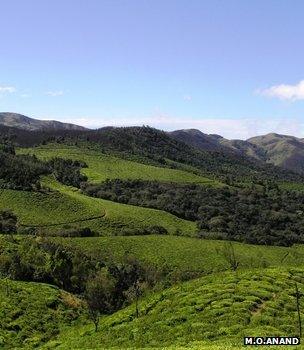Plants at risk from seed dispersal threats
- Published

Large animals, such as elephants, play a vital role in a region's seed dispersal network, the team says
Drivers of biodiversity loss, such as habitat fragmentation and climate change, are threatening seed dispersal around the globe, a study has warned.
Scientists said plant species that were unable to adapt were being driven "to the brink of extinction in most human-modified landscapes".
The way seeds were spread in landscapes had to be given more attention within conservation schemes, they added.
The findings have been published in the journal Biological Conservation, external.
"The global pollination crisis has been acknowledged as being a major concern," said co-author Soumya Prasad, an ecologist at the Centre for Ecological Science at the Indian Institute of Science.
"But there is also a growing crisis around the world when it comes to seed dispersal, yet it is not fully recognised or understood.
"So we reviewed existing information to synthesis it in a form that was not only useful for researchers but also for land managers."
Dr Prasad said that the international team of scientists found that factors identified as the main contributors to biodiversity loss (habitat fragmentation, hunting and over-harvesting, invasive species and climate change) were altering seed dispersal patterns "in very complex ways".
"It changed the quantity of seeds being dispersed; it changed the composition of the species that are being dispersed," she told BBC News.
"And it also changed the pattern of where the seeds were getting to within the landscape."
'Fragmented world'
She used the example of how changes to an area's climate, such as shifts in temperature and precipitation, was forcing plants to "migrate".

Fragmentation of landscapes disrupt long-establish dispersal networks, threatening an area's ecology
"If there are species that cannot adapt to the new conditions, then they have to shift their range.
"However, today, they live in a very fragmented world so the dispersal network has been disrupted by the human-modified landscape," Dr Prasad observed.
"Added to this, many of the large bodied animals that transport seeds, such as elephants, are extremely rare or absent from the non-forest [landscape]."
This meant that the traditional transportation method of seeds becoming attached to the animals was no longer available as a method that allowed the seeds to bridge the fragmented habitat.
"So there is a complex interaction between the drivers," she explained.
"Climate change, fragmentation and animal declines are driving the seed dispersal process to the brink of extinction in most human-modified landscapes today."
Dr Prasad said they used the collated data to see if a better understanding of the impacts of the biodiversity loss driver on seed dispersal networks could be used to develop better management and conservation practices.
"There are definitely ways in which an understanding of this process can improve the way in which we manage our landscapes," she said.
In their paper, the team concluded: "We recommend that the conservation status of functionally unique dispersers be revised and that the conservation target for key seed dispersers should be a population size that maintains their ecological function, rather than merely the minimum viable population."
Dr Prasad said: "The sooner we address the concerns surrounding seed dispersal in modern landscapes, the better we will be able to adapt to the changes in coming decades. "
- Published11 May 2010
- Published14 July 2011
- Published11 November 2011